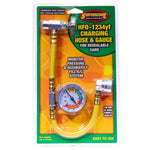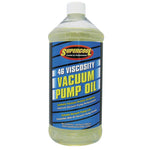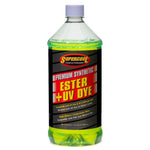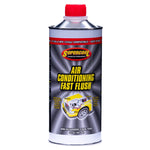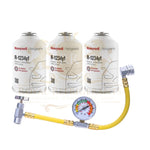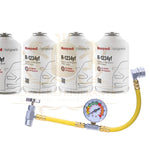You have no items in your shopping cart.
Everything You Need to Know About R-410A Pressure Chart for HVAC and Automotive Applications
If you work with air conditioning or refrigeration systems, understanding refrigerant pressure is essential. One of the most widely used refrigerants today is R-410A, a high-efficiency, environmentally friendly alternative to older refrigerants like R-22.
To service or diagnose an R-410A system properly, you must know how to read and interpret a pressure-temperature (P-T) chart — commonly referred to as the R-410A pressure chart.
In this article, we’ll explain what the R-410A pressure chart is, how to use it for HVAC and (limited) automotive applications, and what pressure readings you should expect during system operation.
What Is R-410A?
R-410A is a hydrofluorocarbon (HFC) refrigerant blend made of R-32 and R-125 in a 50/50 ratio. It is a non-ozone-depleting replacement for R-22, offering:
-
Higher energy efficiency
-
Better heat transfer performance
-
Zero ozone depletion potential (ODP)
R-410A is now the standard refrigerant for residential and commercial HVAC systems worldwide.
Why Pressure Charts Matter
The R-410A pressure chart shows the relationship between temperature and pressure in both the liquid and vapor states of the refrigerant.
Technicians use this chart to:
-
Diagnose A/C system issues
-
Verify proper charge levels
-
Determine superheat and subcooling
-
Identify leaks or blockages
-
Ensure safe system operation
Because refrigerant pressure changes with temperature, knowing the correct pressure for a given temperature helps you maintain peak efficiency and prevent compressor damage.

How to Read an R-410A Pressure Chart
An R-410A P-T chart has two main columns:
-
Temperature (°F or °C)
-
Corresponding Pressure (PSIG or bar)
R-410A operates at much higher pressures than older refrigerants like R-22, so accurate readings are critical.
Here’s a simplified section of an R-410A pressure-temperature chart (in °F and PSIG):
| Temperature (°F) | Pressure (PSIG) |
|---|---|
| 40°F | 118 psig |
| 50°F | 144 psig |
| 60°F | 173 psig |
| 70°F | 205 psig |
| 80°F | 238 psig |
| 90°F | 274 psig |
| 100°F | 313 psig |
| 110°F | 355 psig |
| 120°F | 400 psig |
💡 Note: These values represent saturated conditions — meaning the refrigerant is changing phase between liquid and vapor. Actual system pressures will vary based on ambient temperature, indoor load, and system design.
Typical R-410A Pressure Readings in HVAC Systems
When servicing an air conditioning or heat pump system using R-410A, you can expect pressures to fall within the following ranges:
| System Mode | Low Side (Suction) | High Side (Discharge) |
|---|---|---|
| Cooling Mode (Indoor Temp 75°F) | 115–130 psig | 350–400 psig |
| Heating Mode (Outdoor Temp 45°F) | 140–160 psig | 400–450 psig |
These values are general guidelines — always compare your readings against ambient conditions and manufacturer specifications.
Superheat and Subcooling with R-410A
To fine-tune refrigerant charge and ensure optimal performance, technicians calculate:
Superheat (Evaporator)
-
Superheat = Actual suction line temperature – Saturation temperature (from chart)
-
Ideal range: 8–12°F
Subcooling (Condenser)
-
Subcooling = Saturation temperature (from chart) – Actual liquid line temperature
-
Ideal range: 8–15°F
Using the R-410A pressure chart helps you find the saturation temperature that corresponds to your pressure readings, ensuring proper refrigerant charge and system balance.
Safety and Handling Tips
Because R-410A operates at higher pressures than R-22, it requires:
-
Special gauges and hoses rated for high pressure
-
R-410A-specific manifold sets
-
Recovery cylinders approved for HFC blends
-
POE (polyolester) oil, which is compatible with R-410A
⚠️ Never use R-22 tools or cylinders for R-410A — they cannot handle the pressure and could rupture under stress.
R-410A Pressure Chart in Automotive Applications
While R-410A is primarily used in HVAC systems, it’s occasionally discussed in automotive refrigeration research or specialized transport cooling systems.
However, standard automotive A/C systems do NOT use R-410A — they typically rely on R-134a or R-1234yf.
R-410A’s operating pressure (up to 400+ psig) is far too high for conventional automotive compressors and hoses. Attempting to retrofit R-410A into car A/C systems is unsafe and illegal.
Instead, automotive engineers use R-410A data for testing new high-pressure systems and developing next-generation electric vehicle HVAC systems.
Environmental and Regulatory Information
-
Ozone Depletion Potential (ODP): 0
-
Global Warming Potential (GWP): ~2088
-
Regulatory Phase-Down: Under the Kigali Amendment, production of high-GWP refrigerants like R-410A is gradually being reduced globally.
-
Replacements: Newer refrigerants such as R-32, R-454B, and R-466A are emerging as eco-friendly alternatives.
Maintenance and Troubleshooting Using the R-410A Chart
When using the R-410A pressure chart, consider these diagnostic clues:
| Observation | Possible Issue | Action |
|---|---|---|
| Low suction, low discharge | Undercharge or restriction | Check for leaks or blockages |
| High suction, low discharge | Faulty compressor or low airflow | Inspect motor and filters |
| Low suction, high discharge | Dirty coils or non-condensables | Clean coils, recover and recharge |
| High suction, high discharge | Overcharge | Recover excess refrigerant |
By comparing your pressure readings to the R-410A chart, you can quickly determine system performance and identify abnormalities.
Conclusion
The R-410A pressure chart is an essential tool for HVAC professionals and technicians working with modern A/C systems. It helps ensure accurate diagnostics, proper charging, and safe operation.
While R-410A remains dominant in the HVAC industry, it is gradually being replaced by lower-GWP refrigerants. Nevertheless, understanding how to use the R-410A pressure-temperature chart remains vital for anyone maintaining or servicing existing systems.
For automotive technicians, R-410A serves more as a reference point — not a practical refrigerant — as cars continue to use R-134a and R-1234yf for safety and compatibility reasons.
With correct use of pressure charts, proper equipment, and environmental responsibility, you can ensure efficient and reliable cooling performance for years to come.
 English
English

